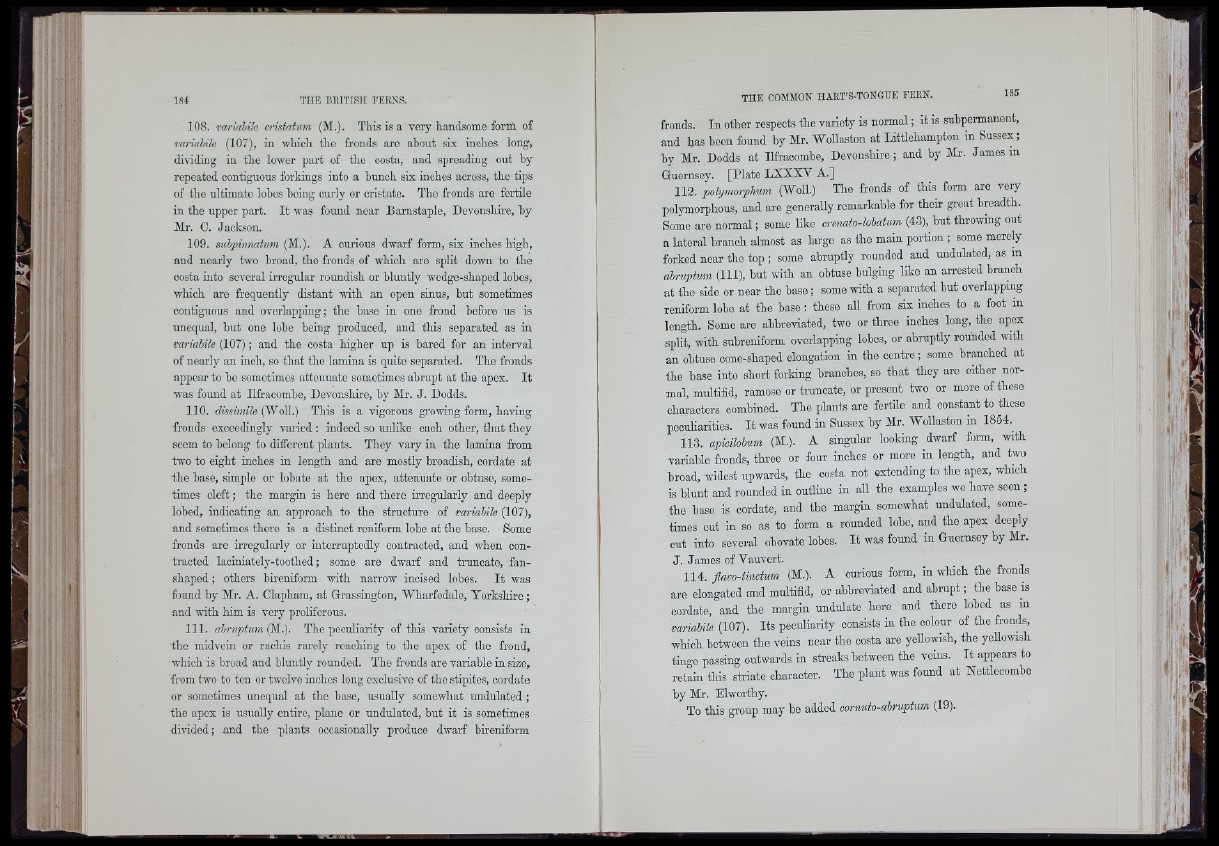
184
108. variahile cristatum (AI.). This is a very handsome form of
mriahile (107), in which tho fronds are about six inches long,
dividing in the lower part of tho costa, and spreading ont by
repeated contiguous forkings into a bunch six inches across, the tips
of tho ultimate lobes being curly or cristate. Tho fronds are fertile
in the upper part. It was found near Barnstaple, Devonshire, by
Air. C. Jackson.
109. suhpinnatum (AI.). A curious dwarf form, six inches high,
and nearly two broad, the fronds of which are split down to the
costa into several irregular roundish or bluntly wedgo-shaped lobes,
which aro frequently distant with an open sinus, but sometimes
contiguous and overlapping; the base in one frond before us is
unequal, but one lobe being produced, and this separated as in
variahile (107); and the oosta higher up is hared for an interval
of nearly an inch, so that the lamina is quite separated. The fronds
appear to be sometimes attenuate sometimes abrupt at the apex. It
was found at Ilfracombe, Devonshire, by Air. J. Dodds.
110. clissimile (AVoU.) This is a vigorous growing form, having
fronds exceedingly varied : indeed so unlike each other, that they
seem to belong to different plants. They vary in the lamina from
two to eight inches in length and are mostly broadish, cordate at
the base, simple or lobate at the apex, attenuate or obtuse, sometimes
cleft; the margin is here and there irregularly and deeply
lobed, indicating an approach to the structure of variabile (107),
and sometimes there is a distinct reniform lobe at the base. Some
fronds are irregularly or Interruptedly contracted, and when contracted
laclniatoly-toothed; some are dwarf and truncate, fanshaped
; others bireniform with narrow incised lohes. It was
found by Air. A. Clapham, at Grassington, AVharfedale, Yorkshire;
and with him is very proliferous.
111. abruptum QsL.). The peculiarity of this variety consists in
tho midvein or raohis rarely reaching to the apex of the frond,
which is broad and bluntly rounded. The fronds are variable in size,
from two to ten or twelve inches long exclusive of the stipites, cordate
or sometimes unequal at the base, usually somewhat undulated ;
the apex is usually entire, plane or undulated, hut it is sometimes
divided; and the plants occasionally produce dwarf bireniform
fronds. In other respects the variety is normal; it is snhpermanent,
and has been found by Mr. AVollaston at Littlehampton in Sussex;
by Air. Dodds at Ilfraoombe, Devonshire ; and by Mr. James in
Guernsey. [Plate LXXXV A.]
112. polymorphum (AVoll.) The fronds of this form aro very
polymorphous, and are generaUy remarkable for their great breadth.
Some are normal; some like crenato-lohatim (43), hut throwing out
a lateral branch almost as large as the main portion ; some merely
forked near tho top ; some abruptly rounded and undulated, as in
abruptum (111), hut with an obtuse bulging like an arrested branch
at the side or near the base; some with a separated but overlapping
reniform lobe at tho base : these all from six inches to a foot in
length. Some are ahhreviatod, two or three inches long, the apex
split, with snbreniform overlapping lobes, or abruptly rounded with
an obtuse cone-shaped elongation in the centre; some branched at
the base into short forking branches, so that they are either normal,
multifid, ramose or truncate, or present two or more of these
characters combined. The plants are fertile and constant to these
peculiarities. It was found in Sussex by Air. AVollaston in 1854.
113. apicilobum (M.). A singular looking dwarf form, with
variable fronds, three or four inches or more in length, and two
broad, widest upwards, the costa not extending to tho apex, which
is blunt and rounded in outline in all the examples we have seen ;
the base is cordate, and the margin somewhat undulated, sometimes
cut in so as to form a rounded lobe, and the apex deeply
ont into several obovate lohes. It was found in Guernsey by Mr.
J. James of Yauvert.
114. flavo-tinctum (M.). A curious form, in which the fronds
are elongated and multifid, or abbreviated and abrupt; the base is
cordate, and the margin undulate here and there lobed as in
variabile (107). Its peculiarity consists in the colour of the fronds,
which between the veins near the oosta are yellowish, the yellowish
tinge passing outwards in streaks between the veins. It appears to
retain this striate character. The plant was found at Nettlecombe
by Air. Elworthy.
To this group may bo added cormto-abruptum (19).
Di 'I
I*
1:1
i >1
' \ A
> .
Milk
ri) A
■ lI i’l
I
: 'If
IM